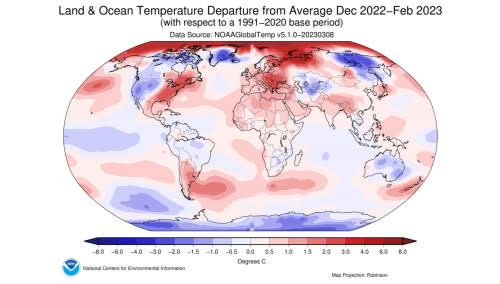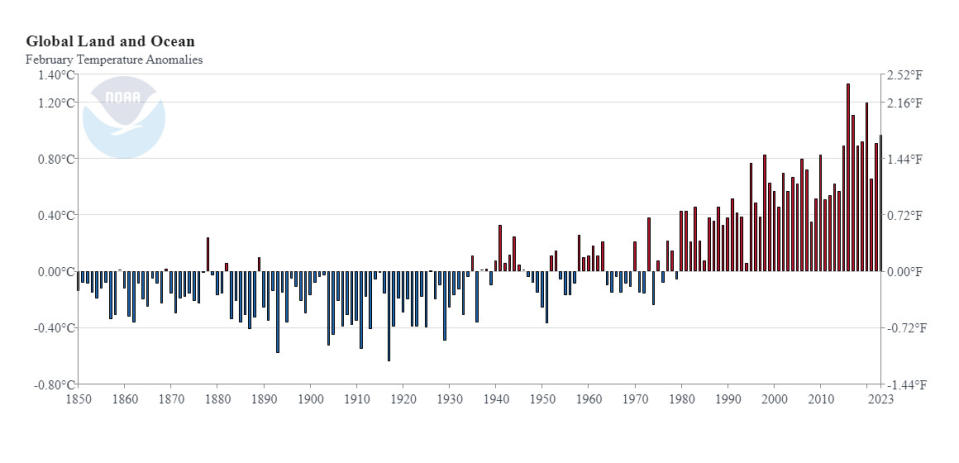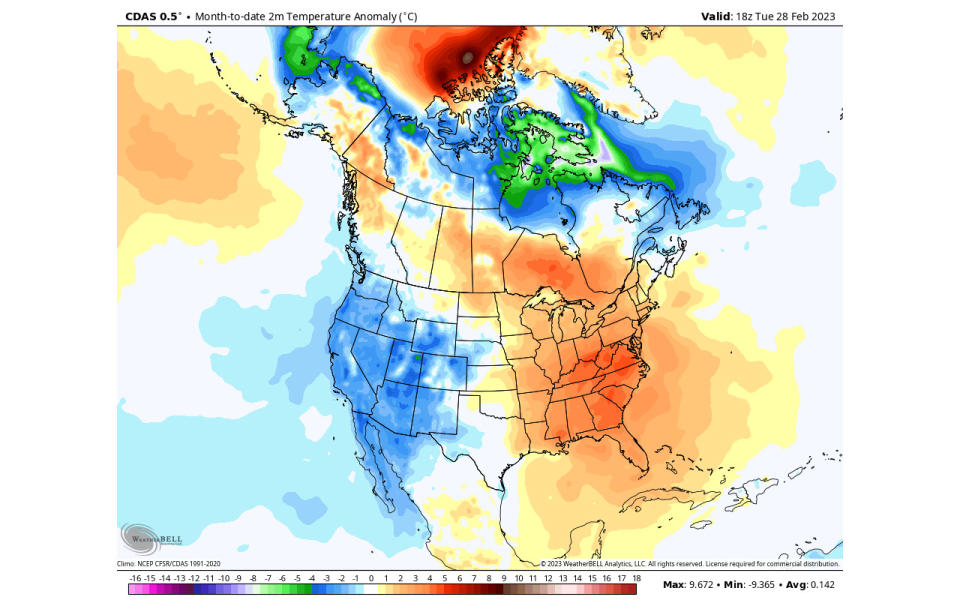This was one of the warmest winters on record for parts of Canada
While the past three months, together, ranked as one of the warmest meteorological winters in the record books, the season was felt very differently across Canada.
According to NOAA and NASA, December 2022 through February 2023 now ranks as the fifth warmest Dec-Feb period in their record books. According to the Japanese Meteorological Agency, it was the fourth warmest. In the northern hemisphere, this three-month period is known as meteorological winter, while it’s meteorological summer in the southern hemisphere.

This map plots how warm or cold conditions were around the world compared to normal over the past three months, providing a regional view of temperatures over the northern winter/southern summer season. Besides the Arctic, which is the fastest-warming region of the globe, the eastern half of Canada and the United States was one of the hottest regions on land for the entire season. (NOAA NCEI)
Taking only northern winter into account, NOAA ranked it as the fifth warmest meteorological winter since 1850. However, the season expressed itself very differently in various parts of the world. Greenland and eastern Siberia saw some of the coldest relative temperatures on the planet during those three months. At the same time, eastern Europe was exceptionally warm, as was the eastern half of North America.
Here in Canada, temperatures split the country in half. In the west, temperatures were even colder than normal. In central and eastern Canada, though, this may have been one of the warmest winters on record.

This temperature map shows the regions across North America that were warmer or colder than the 30-year average (1991-2020) during this past meteorological winter (Dec. 1, 2022 to Feb. 28, 2023), revealing a stark contrast between the eastern and western parts of the continent. (WeatherBell)
Meanwhile, despite the relatively cool meteorological summer experienced over Antarctica, sea ice surrounding the continent tracked at record low levels throughout the season, and set a new all time record for smallest Antarctic sea ice extent on February 21.
Conditions in context
The major climate monitoring agencies around the world — NOAA, NASA, the Copernicus Climate Change Service, and the JMA — are unanimous in their assessment of global temperatures for February 2023.
Last month is now the fourth warmest February in the record books, currently surpassed only by February 2016, 2017, and 2020.

NOAA’s graph of global average temperature anomalies for February 1850-2023 reveals how the month has been getting warmer over the years as global temperatures rise. February 2023 is now the fourth warmest in the entire record. (NOAA NCEI)
“February 2023 marked the 44th-consecutive February and the 528th-consecutive month with temperatures above the 20th-century average,” NOAA stated in a press release.
“Regionally, Asia had its seventh-warmest February on record, while South America, Europe and Africa all saw a top-20 warm February. North America and Oceania both had a warmer-than-average February, although temperatures did not rank among the top-20 warmest,” they added.
The reason February did not rank higher for North America is again the stark temperature contrast between the east and west that persisted through the month.

This map of temperature anomalies from February 2023 shows a similar pattern across North America to what occurred throughout all of meteorological winter. (WeatherBell)
Temperatures to rise with La Niña’s end
Together, January and February of 2023 were exceptionally warm for the globe, with NOAA slotting this Jan-Feb period into their records as the 4th hottest so far.
Although La Niña had been keeping the globe slightly cooler over the past few years, patterns have now shifted. With the end of that rare triple-dip La Niña, global temperatures are expected to rise throughout the year.
Even with just the first two months of the year recorded, NOAA is already “virtually certain” that 2023 will be in the top 10 hottest years on record, and there’s a 65 per cent chance that it will be one of the top five.
(Thumbnail image courtesy NASA’s Goddard Institute for Space Studies)

